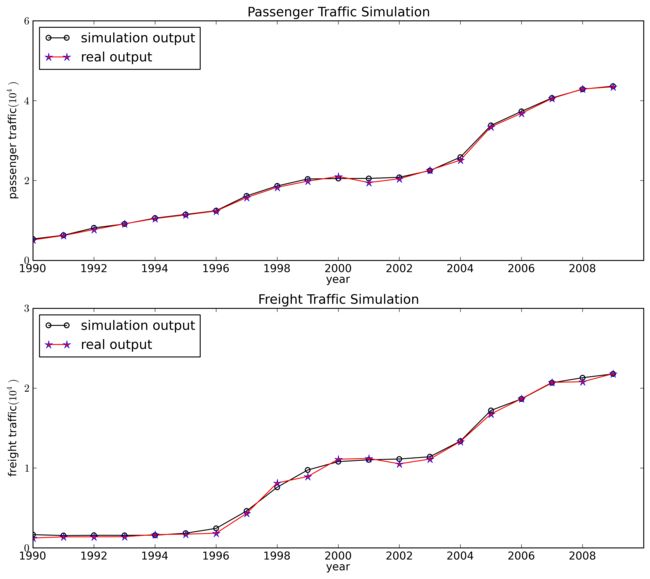BP神经网络Python实现
作者:金良([email protected]) csdn博客:http://blog.csdn.net/u012176591
训练数据
| 年份 | 人口数量/万人 | 机动车数量/万辆 | 公路面积/万平方千米 | 公路客运量/万人 | 公路货运量/万吨 |
| 1990 | 20.55 | 0.6 | 0.09 | 5126 | 1237 |
| 1991 | 22.44 | 0.75 | 0.11 | 6217 | 1379 |
| 1992 | 25.37 | 0.85 | 0.11 | 7730 | 1385 |
| 1993 | 27.13 | 0.90 | 0.14 | 9145 | 1399 |
| 1994 | 29.45 | 1.05 | 0.20 | 10460 | 1663 |
| 1995 | 30.1 | 1.35 | 0.23 | 11387 | 1714 |
| 1996 | 30.96 | 1.45 | 0.23 | 12353 | 1834 |
| 1997 | 34.06 | 1.60 | 0.32 | 15750 | 4322 |
| 1998 | 36.42 | 1.70 | 0.32 | 18304 | 8132 |
| 1999 | 38.09 | 1.85 | 0.34 | 19836 | 8936 |
| 2000 | 39.13 | 2.15 | 0.36 | 21024 | 11099 |
| 2001 | 39.99 | 2.20 | 0.36 | 19490 | 11203 |
| 2002 | 41.93 | 2.25 | 0.38 | 20433 | 10524 |
| 2003 | 44.59 | 2.35 | 0.49 | 22598 | 11115 |
| 2004 | 47.30 | 2.50 | 0.56 | 25107 | 13320 |
| 2005 | 52.89 | 2.60 | 0.59 | 33442 | 16762 |
| 2006 | 55.73 | 2.70 | 0.59 | 36836 | 18673 |
| 2007 | 56.76 | 2.85 | 0.67 | 40548 | 20724 |
| 2008 | 59.17 | 2.95 | 0.69 | 42927 | 20803 |
| 2009 | 60.63 | 3.10 | 0.79 | 43462 | 21804 |
人工神经网络源码
import numpy as np
import matplotlib.pyplot as plt
def logsig(x):
return 1/(1+np.exp(-x))
#人数(单位:万人)
population=[20.55,22.44,25.37,27.13,29.45,30.10,30.96,34.06,36.42,38.09,39.13,39.99,41.93,44.59,47.30,52.89,55.73,56.76,59.17,60.63]
#机动车数(单位:万辆)
vehicle=[0.6,0.75,0.85,0.9,1.05,1.35,1.45,1.6,1.7,1.85,2.15,2.2,2.25,2.35,2.5,2.6,2.7,2.85,2.95,3.1]
#公路面积(单位:万平方公里)
roadarea=[0.09,0.11,0.11,0.14,0.20,0.23,0.23,0.32,0.32,0.34,0.36,0.36,0.38,0.49,0.56,0.59,0.59,0.67,0.69,0.79]
#公路客运量(单位:万人)
passengertraffic=[5126,6217,7730,9145,10460,11387,12353,15750,18304,19836,21024,19490,20433,22598,25107,33442,36836,40548,42927,43462]
#公路货运量(单位:万吨)
freighttraffic=[1237,1379,1385,1399,1663,1714,1834,4322,8132,8936,11099,11203,10524,11115,13320,16762,18673,20724,20803,21804]
samplein = np.mat([population,vehicle,roadarea]) #3*20
sampleinminmax = np.array([samplein.min(axis=1).T.tolist()[0],samplein.max(axis=1).T.tolist()[0]]).transpose()#3*2,对应最大值最小值
sampleout = np.mat([passengertraffic,freighttraffic])#2*20
sampleoutminmax = np.array([sampleout.min(axis=1).T.tolist()[0],sampleout.max(axis=1).T.tolist()[0]]).transpose()#2*2,对应最大值最小值
#3*20
sampleinnorm = (2*(np.array(samplein.T)-sampleinminmax.transpose()[0])/(sampleinminmax.transpose()[1]-sampleinminmax.transpose()[0])-1).transpose()
#2*20
sampleoutnorm = (2*(np.array(sampleout.T).astype(float)-sampleoutminmax.transpose()[0])/(sampleoutminmax.transpose()[1]-sampleoutminmax.transpose()[0])-1).transpose()
#给输出样本添加噪音
noise = 0.03*np.random.rand(sampleoutnorm.shape[0],sampleoutnorm.shape[1])
sampleoutnorm += noise
maxepochs = 60000
learnrate = 0.035
errorfinal = 0.65*10**(-3)
samnum = 20
indim = 3
outdim = 2
hiddenunitnum = 8
w1 = 0.5*np.random.rand(hiddenunitnum,indim)-0.1
b1 = 0.5*np.random.rand(hiddenunitnum,1)-0.1
w2 = 0.5*np.random.rand(outdim,hiddenunitnum)-0.1
b2 = 0.5*np.random.rand(outdim,1)-0.1
errhistory = []
for i in range(maxepochs):
hiddenout = logsig((np.dot(w1,sampleinnorm).transpose()+b1.transpose())).transpose()
networkout = (np.dot(w2,hiddenout).transpose()+b2.transpose()).transpose()
err = sampleoutnorm - networkout
sse = sum(sum(err**2))
errhistory.append(sse)
if sse < errorfinal:
break
delta2 = err
delta1 = np.dot(w2.transpose(),delta2)*hiddenout*(1-hiddenout)
dw2 = np.dot(delta2,hiddenout.transpose())
db2 = np.dot(delta2,np.ones((samnum,1)))
dw1 = np.dot(delta1,sampleinnorm.transpose())
db1 = np.dot(delta1,np.ones((samnum,1)))
w2 += learnrate*dw2
b2 += learnrate*db2
w1 += learnrate*dw1
b1 += learnrate*db1
# 误差曲线图
errhistory10 = np.log10(errhistory)
minerr = min(errhistory10)
plt.plot(errhistory10)
plt.plot(range(0,i+1000,1000),[minerr]*len(range(0,i+1000,1000)))
ax=plt.gca()
ax.set_yticks([-2,-1,0,1,2,minerr])
ax.set_yticklabels([u'$10^{-2}$',u'$10^{-1}$',u'$1$',u'$10^{1}$',u'$10^{2}$',str(('%.4f'%np.power(10,minerr)))])
ax.set_xlabel('iteration')
ax.set_ylabel('error')
ax.set_title('Error History')
plt.savefig('errorhistory.png',dpi=700)
plt.close()
# 仿真输出和实际输出对比图
hiddenout = logsig((np.dot(w1,sampleinnorm).transpose()+b1.transpose())).transpose()
networkout = (np.dot(w2,hiddenout).transpose()+b2.transpose()).transpose()
diff = sampleoutminmax[:,1]-sampleoutminmax[:,0]
networkout2 = (networkout+1)/2
networkout2[0] = networkout2[0]*diff[0]+sampleoutminmax[0][0]
networkout2[1] = networkout2[1]*diff[1]+sampleoutminmax[1][0]
sampleout = np.array(sampleout)
fig,axes = plt.subplots(nrows=2,ncols=1,figsize=(12,10))
line1, =axes[0].plot(networkout2[0],'k',marker = u'$\circ$')
line2, = axes[0].plot(sampleout[0],'r',markeredgecolor='b',marker = u'$\star$',markersize=9)
axes[0].legend((line1,line2),('simulation output','real output'),loc = 'upper left')
yticks = [0,20000,40000,60000]
ytickslabel = [u'$0$',u'$2$',u'$4$',u'$6$']
axes[0].set_yticks(yticks)
axes[0].set_yticklabels(ytickslabel)
axes[0].set_ylabel(u'passenger traffic$(10^4)$')
xticks = range(0,20,2)
xtickslabel = range(1990,2010,2)
axes[0].set_xticks(xticks)
axes[0].set_xticklabels(xtickslabel)
axes[0].set_xlabel(u'year')
axes[0].set_title('Passenger Traffic Simulation')
line3, = axes[1].plot(networkout2[1],'k',marker = u'$\circ$')
line4, = axes[1].plot(sampleout[1],'r',markeredgecolor='b',marker = u'$\star$',markersize=9)
axes[1].legend((line3,line4),('simulation output','real output'),loc = 'upper left')
yticks = [0,10000,20000,30000]
ytickslabel = [u'$0$',u'$1$',u'$2$',u'$3$']
axes[1].set_yticks(yticks)
axes[1].set_yticklabels(ytickslabel)
axes[1].set_ylabel(u'freight traffic$(10^4)$')
xticks = range(0,20,2)
xtickslabel = range(1990,2010,2)
axes[1].set_xticks(xticks)
axes[1].set_xticklabels(xtickslabel)
axes[1].set_xlabel(u'year')
axes[1].set_title('Freight Traffic Simulation')
fig.savefig('simulation.png',dpi=500,bbox_inches='tight')
plt.close()
